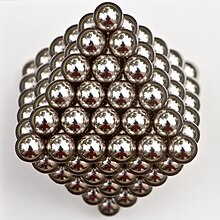Octahedral number

In number theory, an octahedral number is a figurate number that represents the number of spheres in an octahedron formed from close-packed spheres. The nth octahedral number can be obtained by the formula:[1]
The first few octahedral numbers are:
Properties and applications
The octahedral numbers have a generating function
Sir Frederick Pollock conjectured in 1850 that every number is the sum of at most 7 octahedral numbers: see Pollock octahedral numbers conjecture.[2]
In chemistry, octahedral numbers may be used to describe the numbers of atoms in octahedral clusters; in this context they are called magic numbers.[3][4]
Relation to other figurate numbers
Square pyramids

An octahedral packing of spheres may be partitioned into two square pyramids, one upside-down underneath the other, by splitting it along a square cross-section. Therefore, the nth octahedral number can be obtained by adding two consecutive square pyramidal numbers together:[1]
Tetrahedra
If is the nth octahedral number and is the nth tetrahedral number then
This represents the geometric fact that gluing a tetrahedron onto four corners of an octahedron produces a larger tetrahedron. Another relation between octahedral numbers and tetrahedral numbers is also possible, based on the fact that an octahedron may be divided along a line between two opposite vertices into four tetrahedra[4] (or alternatively, based on the fact that each square pyramidal number is the sum of two tetrahedral numbers):
Cubes
If two tetrahedra are attached to opposite faces of an octahedron, the result is a rhombohedron.[5] The number of close-packed spheres in the rhombohedron is a cube, justifying the equation
Centered squares
The difference between two consecutive octahedral numbers is a centered square number:[1]
Therefore, an octahedral number also represents the number of points in a square pyramid formed by stacking centered squares; for this reason, in his book Arithmeticorum libri duo (1575), Francesco Maurolico called these numbers "pyramides quadratae secundae".[6]
The number of cubes in an octahedron formed by stacking centered squares is a centered octahedral number, the sum of two consecutive octahedral numbers. These numbers are
given by the formula
References
- ^ a b c Conway, John Horton; Guy, Richard K. (1996), The Book of Numbers, Springer-Verlag, p. 50, ISBN 9780387979939.
- ^ Dickson, L. E. (2005), History of the Theory of Numbers, Vol. 2: Diophantine Analysis, New York: Dover, pp. 22–23.
- ^ Teo, Boon K.; Sloane, N. J. A. (1985), "Magic numbers in polygonal and polyhedral clusters" (PDF), Inorganic Chemistry, 24 (26): 4545–4558, doi:10.1021/ic00220a025.
- ^ a b Feldheim, Daniel L.; Foss, Colby A. (2002), Metal nanoparticles: synthesis, characterization, and applications, CRC Press, p. 76, ISBN 9780824706043.
- ^ Burke, John G. (1966), Origins of the science of crystals, University of California Press, p. 88.
- ^ Tables of integer sequences from Arithmeticorum libri duo, retrieved 2011-04-07.










